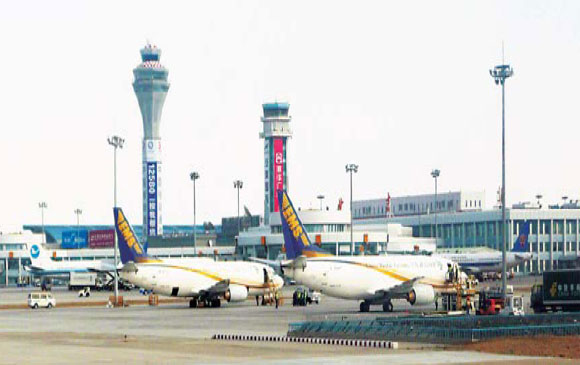China sets aside $64b for airport shuffle
|
Beijing Capital International Airport, the civil aviation hub in north China. Zhang Heping |
China drafted a long-term plan for development of air cargo, which will require the building of 97 new airports, consolidation of smaller airports and upgrading of certain key airports by the year 2020. The entire project will cost the government a massive investment of $64 billion.
Under the plan, 97 feeder-line airports will be built across the country, the main air hubs will be upgraded, and airport clusters will be set up in the northern, eastern, central, southern, southwestern and northwestern parts of the country, according to the new Ministry of Transport.
The ministry, which was formed on March 24, encompasses all the state entities related to road, sea and air traffic. It is evolved from the former Ministry of Communications and the General Administration of the Civil Aviation of China.
By the end of 2006, the Chinese mainland had 147 airports with 45 of them serving both military and civilian traffic.
The program calls for the forming of airport clusters according to their function - international, domestic or feeder airports - and integration of large, small and medium-sized airports. The main goal is balanced development of airports with improved coordination among airports and between trunk and feeder routes, and increased capacity of medium-sized and large airports.
Under the plan for northern China, Beijing will have a second airport and the existing Capital International Airport will be upgraded into an international hub.
Discussions have been continuing since 2002 on which airport will be Beijing's second aviation facility. The main contenders are Tianjin, Langfang in Hebei province and Daxing district in Beijing. Yang Guoqing, a senior civil aviation official, said that the final decision would not be made until 2010.
The other top airports that are to be upgraded are Pudong International Airport in Shanghai and New Baiyun International Airport in Guangzhou - both have been selected to grow into international air cargo hubs.
New Baiyun will continue to offer subsidies to cargo airlines to start more freighter routes and will open a cargo station in Dongguan for Customs clearance in a bid to lower costs. The station will be linked to the cargo center at New Baiyun through an information platform. By the end of this year FedEx is expected to begin operations at its cargo terminal.
Chen Xiaoning, vice-president of Guangdong Airport Management Corporation, said the airport has reserved space for cargo development near the fourth runway, which will start construction this year and will be completed by 2010.
At Pudong Airport, handling capacity has been the main challenge even though the western part of the airport provided 1.2 million tons of additional cargo capacity this month following the opening of the third runway.
Bettina Ganghofer, deputy general manager of the Shanghai Pudong Airport Cargo Terminal, said a 140,000 sq m warehouse will be built with more facilities for perishable cargo in the western part of the airport.
In central China, the airports in Wuhan and Zhengzhou will be upgraded as regional centers. And Shenyang's Taoxian International Airport will assume the role of an air center for Northeast China.
Of the 97 new airports, more than half will be built in Southwest and Northwest China to speed up development of domestic traffic. Among them, Kunming will be made a gateway airport, linking China with South Asia and Southeast Asia, and will be supported by the airports in Chengdu and Chongqing.
Urumqi in Northwest China's Xinjiang Uygur Autonomous Region will play an identical role as Kunming to promote trade between China and Central Asia, and its supporters will be the airports in Xi'an and Lhasa.
Source: Logistics China, a monthly English review published by Chinadaily.com.cn
(China Daily 06/16/2008 page16)









